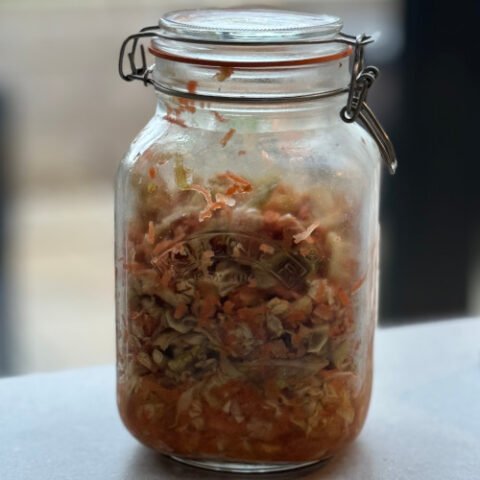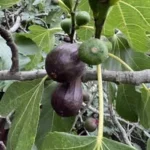
Vibrant green kimchi recipe: the ultimate fermented power food
Discover the vibrant world of green kimchi made with green cabbage and gochugaru. This plant-based twist on the Korean classic is rich in probiotics, bold in flavour, and packed with energising nutrients for gut health and vitality.
Ingredients
- 500g green cabbage
- 2 onions, thinly sliced
- 2 carrots, grated
- 10 garlic cloves, minced
- Thumb-sized ginger, minced
- 2 apples, grated
- 5 tbsp Gochugaru (Korean chilli flakes), or Gochugaru paste
- 2% sea salt
- 1 sheet of nori or cling film
Instructions
- Add all the ingredients to a large mixing bowl & weigh the contents. Determine what 2% of the weight is, then add that amount to the sea salt.
- Using gloves, massage the ingredients with salt for 5 minutes or so. Then, cover the bowl with a clean kitchen cloth. Set the bowl aside for at least 2 hours to allow the natural brine to draw out.
- Transfer the kimchi to a clean jar, then place a sheet of nori directly over the top. If you don't have nori sheets, use cling film instead.
- Leave the kimchi ferment out of the fridge for about 7 days. Then transfer it to the refrigerator where it will store for up to 3 months.
Nutrition Information:
Yield: 10 Serving Size: 1Amount Per Serving: Calories: 49Total Fat: 0gSaturated Fat: 0gTrans Fat: 0gUnsaturated Fat: 0gCholesterol: 0mgSodium: 70mgCarbohydrates: 12gFiber: 2gSugar: 6gProtein: 1g
Green Kimchi Recipe – Origins, Fun Facts and Health Benefits
Green kimchi recipe lovers rejoice — this vibrant twist on Korea’s national dish combines crunchy green cabbage with spicy gochugaru, creating a lighter, plant-based version that’s as flavourful as it is nourishing. It’s bold, probiotic-rich, and loaded with gut-friendly benefits that make it perfect for anyone seeking a healthy, energising fermented food.
A Bite of History
Kimchi’s story stretches back over 3,000 years. Early records from the Three Kingdoms period (around 37 BCE to 7 CE) mention preserved vegetables stored in earthenware pots called onggi. These vessels allowed lactic acid bacteria to flourish naturally, transforming simple vegetables into a shelf-stable, vitamin-rich food source that sustained Koreans through harsh winters.
The addition of chilli peppers came later, in the 17th century, after they were introduced from the Americas. This marked the birth of the spicy red kimchi we know today. Before that, kimchi was often white (baek-kimchi), seasoned with garlic, ginger, and salt but without any heat. Your green kimchi version echoes those earlier styles — lighter, fresher, and perfect for pairing with plant-based meals.
Learn more about kimchi’s fascinating history on the official Korean Food Foundation website
Fun Facts About Kimchi
- Over 200 Variants Exist!
Every Korean household has its own unique recipe, with ingredients changing by region, season, and even family tradition. - National Treasure Status
In 2013, UNESCO recognised kimchi-making (kimjang) as an Intangible Cultural Heritage of Humanity — celebrating its role in community and culture. - A Space Traveller’s Food
In 2008, specially sterilised kimchi was sent into space with Korean astronaut Yi So-yeon, proving that even orbit couldn’t separate Koreans from their beloved dish.
Health Benefits of Kimchi
The magic of kimchi lies in fermentation — a natural process that transforms raw cabbage into a probiotic powerhouse. During fermentation, Lactobacillus bacteria convert sugars into lactic acid, which not only preserves the vegetables but also promotes healthy digestion and a balanced gut microbiome.
Top health benefits include:
- Improved Gut Health: Probiotics help maintain healthy intestinal flora, reducing bloating and improving nutrient absorption.
- Boosted Immunity: A healthy gut supports a strong immune system, especially important during seasonal changes.
- Rich in Vitamins: Kimchi is loaded with vitamins A, C, and K, along with folate and fibre.
- Low in Calories: A flavour-packed addition to any meal without adding excess calories.
For athletes and active individuals, kimchi can also play a surprising role — by aiding recovery and digestion after high-fibre or protein-rich meals. Its natural electrolytes help replenish what’s lost during intense workouts or endurance events.
If you’re exploring plant-based performance foods, check out our article on Oat Energy Bars — another great source of sustained energy and gut-friendly fibre.
The Role of Gochugaru and Green Cabbage
The star ingredients in this green kimchi recipe are what make it so vibrant and distinctive.
Gochugaru, Korean red pepper flakes, bring smoky warmth and mild heat, loaded with antioxidants and vitamin E. Meanwhile, green cabbage provides a crisp bite, natural sweetness, and heaps of vitamin K for bone and muscle health.
Together, they create a balance of flavour and function — bright, earthy, spicy, and delightfully crunchy.
Final Thoughts
Fermentation is more than a cooking technique — it’s an ancient act of nourishment. This green kimchi recipe not only connects you to Korean culinary history but also fuels your modern, plant-powered lifestyle. Whether you eat it fresh or let it ferment for a few days, it delivers gut-loving probiotics, vitamins, and a punch of flavour in every bite.
Add a spoonful alongside rice bowls, tofu dishes, or even avocado toast — and bring a taste of Korea’s heritage to your table, the green kimchi way.



